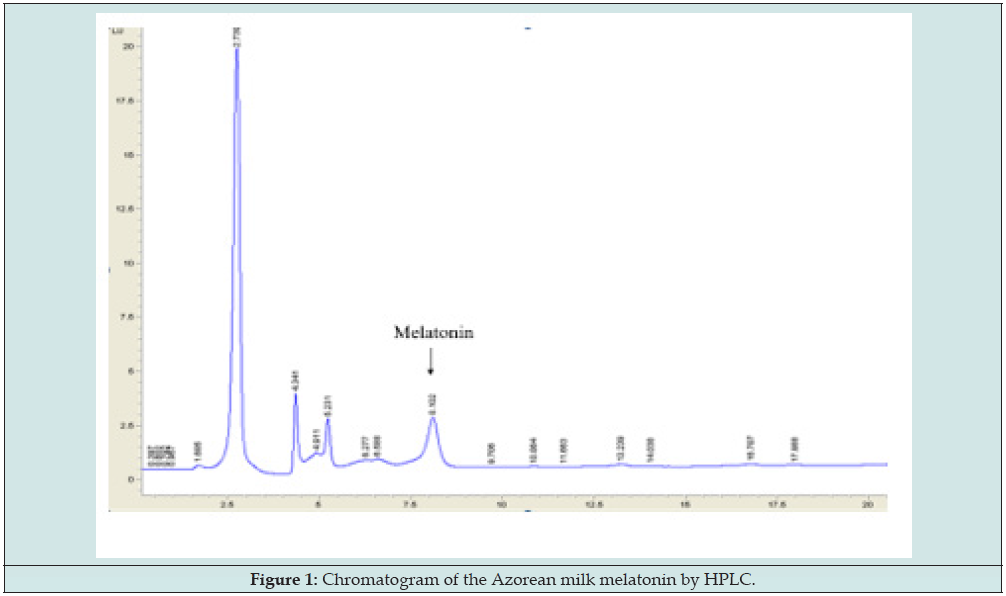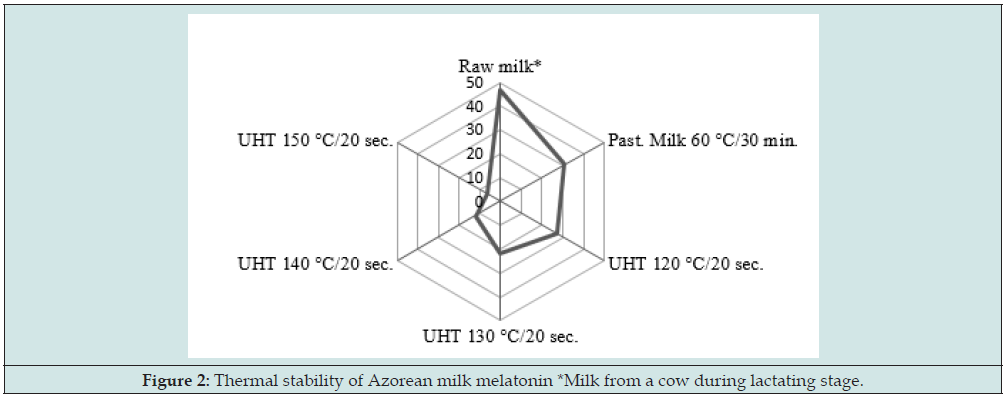
Lupine Publishers Group
Lupine Publishers
Menu
ISSN: 2637-4749
Short Communication(ISSN: 2637-4749) 
Determination of Melatonin in Azorean Bovine Milk by RPHPLC as a Supplement for Sleepless Senior Population Volume 5 - Issue 2
Paiva Lisete1,2 and Baptista José1,2*
- 1Department of Physics, Chemistry and Engineering (DCFQE), Faculty of Science and Technology, University of Azores, Portugal
- 2Institute of Agricultural and Environmental Research and Technology (IITAA), University of Azores, Portugal
Received: February 09, 2023; Published: February 13, 2023
Corresponding author: Baptista, José, Department of Physics, Chemistry and Engineering (DCFQE), Faculty of Science and Technology, University of Azores, Portugal, Institute of Agricultural and Environmental Research and Technology (IITAA), University of Azores, Portugal
DOI: 10.32474/CDVS.2023.05.000210
Abstract
Melatonin (N-acetil-5-metoxitriptamine) is an indoleamine that is synthesized from the essential amino acid tryptophan via 5-hydroxytryptophan, serotonin and N-acetylserotonin in the vertebrate’s pineal gland, particularly during the nocturnal period (light suppress its biosynthesis) [1,2]. This neurohormone decreases with advancing age, paralleled by a deterioration of normal sleeping pattern and changes in circadian rhythmicity. It is frequently used as a sleep prescribed drug to reduce the symptoms associated to jetleg or shift work [3]. Furthermore, melatonin mediates many neuro-physiological, neuro-endocrinological and behavioral processes, and also participate in several other cellular functions, such as: cancers, Alzheimer`s disease, and depressive syndrome [4].
The objective of this study was the determination of melatonin in Azorean bovine milk (in the range of ppt), in order to make a good use of milk’s melatonin to supplement senior people that, generally, presents low level of this neurohormone, fact that increases with the progression of the ageing process. The results shows that Azorean milk melatonin level change according to the season of the year and also according to the nocturnal or diurnal milked periods, showing an average of 40.2 and 78.9 pg/ mL for diurnal and nocturnal periods, during winter period, respectively, and the values of 13.20 and 28.7 pg/mL for diurnal and nocturnal during summertime, respectively. The results also show that the heating treatment affect the melatonin content in the milk, revealing a decreasing level from the raw (46 pg/mL) to the pasteurized (31 pg/mL) and ultra-pasteurized (decreasing from 27 pg/mL at 120°C to 6.6 pg/mL at 150°C).
Keywords:Melatonin; azorean bovine milk; pineal gland; HPLC melatonin determination; sleep patterns.
Methodology, Results and Discussion
The melatonin level was determined in milk collected in three different locations farms in São Miguel Island (Azores) from the nocturnal and diurnal periods, following the Egoshi methodology with some modifications. This methodology includes the precolumn oxidation of melatonin into a highly fluorescent compound N-[(6- methoxy-4-oxo1,4-dihydroquinolin-3-yl)methyl]acetamide(6- MOQMA), and the determination of 6-MOQMA was achieved by high pressure liquid chromatography (HPLC) in an Omni Sphere C18- 5μm reversed-phase column, using the following mobile phase: A – 50 mm NaH2PO4 (pH 7.0) and B – CH3CN. Gradient: t=0 min - 15% B; t=15 min - 18% B; Flow rate - 0.6 mL/min.; Injection volume: 100 μL and Fluorescence Detector: 245 nm (excitation) and 380 nm (emission) (Figure 1).
The results show that the Azorean bovine milk melatonin levels change according to the season of the year, to the nocturnal or diurnal milked periods, and also to the heating treatment. The literature reported values of melatonin milk content (36.72 pg/mL [5] and 41.94 pg/mL [6]) were significantly lower with respect to our results, 13.2 pg/mL (summer) and 45.1 pg/mL (winter) for diurnal period and 28.7 pg/mL (summer) and 92.5 pg/mL (winter) for nocturnal period, that can be explained by the longer winter nights (Table 1). These results may be related to differences in terms of extraction/analysis methodologies, and by genetics, geographical location, time of milking collection, variables related with illuminance, storage conditions, and particularly the lactating stage that stimulate higher melatonin production (local B). The melatonin thermal stability was determined at different temperatures from raw milk to pasteurized milk at 60°C, following the ultra-pasteurized (UHT) milk from 120 - 150°C, that show melatonin´s stabilization decrease with increased temperature (Figure 2).
*Milk from a cow during lactating stage.
Conclusion
The determination of milk melatonin was successfully achieved by HPLC in the range of ppt. The Azorean bovine milk melatonin level changes according to the weather/season of the year, to the nocturnal or diurnal milked periods, and also according to the heating treatment, from the raw, pasteurized and ultra-pasteurized milk. The variables related to illuminance have greater effects on the melatonin concentration in cow’s milk than other factors, particularly the time of milking. The melatonin concentrations obtained from the night milk will be a beneficial supplement for human health, particularly for senior people.
References
- Arendt J, Skene D J (2005) Melatonin as a chronobiotic. Sleep Med Rev 9(1): 25-39.
- Zhdanova I V, Wurtman R J, Regan M M, Taylor J A, Shi J P, et al. (2001) Melatonin Treatment for Age-Related Insomnia. J Clin Endocrinol Metab 86(10): 4727-4730.
- Nelson W G, De Marzo A M, Isaacs W B (2003) Prostate cancer. N Engl J Med 349(4): 366-381.
- Egoshi K, Oka T, Yamashita H (2006) Methods for the extraction of Melatonin from raw milk. Kurume shin-AI Women´s College Bulletin 29: 31-38.
- Milagres M P, Minim V P R, Minim L A, Simiqueli A A, Moraes L E S, et al. (2014) Night milking adds value to cow’s milk. J Sci Food Agric 94(8): 1688-1692.
- Romanini E B, Volpato A M, Santos J S, Santana E H W, Souza C H B, et al. (2019) Melatonin concentration in cow’s milk and sources of its variation. J Appl Anim Res 47:(1) 140-145.

Top Editors
-

Mark E Smith
Bio chemistry
University of Texas Medical Branch, USA -

Lawrence A Presley
Department of Criminal Justice
Liberty University, USA -

Thomas W Miller
Department of Psychiatry
University of Kentucky, USA -

Gjumrakch Aliev
Department of Medicine
Gally International Biomedical Research & Consulting LLC, USA -

Christopher Bryant
Department of Urbanisation and Agricultural
Montreal university, USA -

Robert William Frare
Oral & Maxillofacial Pathology
New York University, USA -

Rudolph Modesto Navari
Gastroenterology and Hepatology
University of Alabama, UK -

Andrew Hague
Department of Medicine
Universities of Bradford, UK -

George Gregory Buttigieg
Maltese College of Obstetrics and Gynaecology, Europe -

Chen-Hsiung Yeh
Oncology
Circulogene Theranostics, England -
.png)
Emilio Bucio-Carrillo
Radiation Chemistry
National University of Mexico, USA -
.jpg)
Casey J Grenier
Analytical Chemistry
Wentworth Institute of Technology, USA -
Hany Atalah
Minimally Invasive Surgery
Mercer University school of Medicine, USA -

Abu-Hussein Muhamad
Pediatric Dentistry
University of Athens , Greece

The annual scholar awards from Lupine Publishers honor a selected number Read More...







